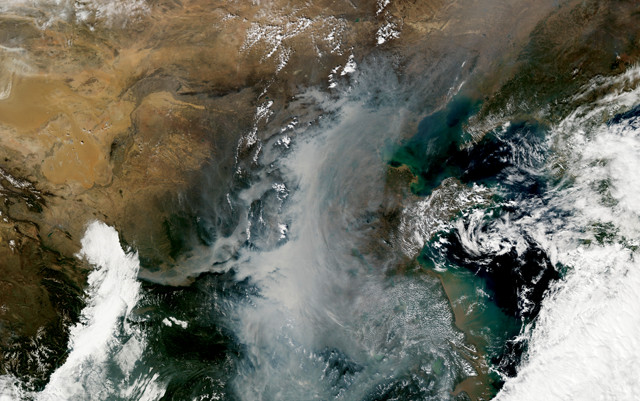
by Lucas Joel Thursday, August 10, 2017

Smog blankets eastern China in this satellite image from October 2010. Credit: NASA.
Air pollution often enshrouds cities in eastern China in a thick haze that impairs visibility and causes respiratory health problems. Emissions from human activity are mainly to blame, but climate researchers now report that natural forces — namely, dust kicked into the air by wind — can also exert a strong control over how much pollution persists in the air.
The phenomenon results from the interplay of several variables — including winds, solar heating of the land and sea, and the properties of airborne dust.
Normally, “when the sun rises in the morning, the land heats up more quickly than the ocean next to it, and what we have is the hot land-air tending to rise,” explains climate researcher Lynn Russell of the Scripps Institution of Oceanography at the University of California, San Diego, co-author of the new Nature Communications study. “Once that air rises, there’s a vacuum below that sucks in the air from over the ocean and creates a sea breeze that can blow away air pollution.”
Airborne dust, though, can alter this dynamic. Dust blown into eastern China from places like the Gobi Desert reflects solar energy back into space. When there is a lot of dust, there is less energy heating the land and the ocean. But less dust allows more energy to reach the surface. Because land and water warm at different rates, the additional energy actually results in a smaller temperature difference between the land and sea. This leads to weaker winds, worsening pollution episodes by creating “stagnation events,” Russell says, during which polluted air stays put over cities. In other words, less dust makes pollution worse; more dust would make pollution blow away more easily.
Russell and her co-authors used the Community Earth System Model (CESM) to simulate the effect Earth’s winds in general have on dust levels and, thus, on pollution levels. They found that in years when dust levels were reduced by about 29 percent, for example, eastern China would see a 13 percent increase in aerosol concentrations, Russell explains. Aerosols are those substances that make air pollution in eastern Chinese cities so bad — they include particulates like sulfates and black carbon.
Under stagnation-event-enhancing conditions, sea breeze speeds decreased on average by about 0.06 meters per second. “This small change in the average reflects a larger change in the range and variability of wind speeds in certain regions,” she says.
The researchers “made a very convincing case” about how natural dust can affect pollution, says Yi Ming, an atmospheric scientist at NOAA’s Geophysical Fluid Dynamics Laboratory in Princeton, N.J., who was not involved in the work. Part of what makes the study’s findings compelling is that the team’s modeling results correlate well with actual observations of the effects of dust in different Chinese cities, Ming says. The real-world observations show that when dust storms occurred in areas like the Gobi Desert, air quality in eastern Chinese cities deteriorated in the following few days as dust levels decreased after the storm, Russell says.
One limitation of these observations, though, is that they go back less than 10 years, and some meteorological cycles that can affect wind-blown dust levels — like the El Niño Southern Oscillation — only happen every five to seven years, Russell says, so the data might not capture the full range of natural variability. “We’re interested in how these things change as the climate changes, but that’s a very slow trend,” she says, and more extensive records would help the team correlate changes in dust concentrations with changes in global temperature.
The next step is to see whether or not the same results emerge in climate models other than the CESM, Ming says. Since each global climate model may yield different results, he says, it would be beneficial for other research groups to look at the same problem to see how robust the new findings are.
© 2008-2021. All rights reserved. Any copying, redistribution or retransmission of any of the contents of this service without the expressed written permission of the American Geosciences Institute is expressly prohibited. Click here for all copyright requests.